Disclosure: This article contains affiliate links. We may earn a commission from purchases at no extra cost to you, which helps our travel content.
The moment I stepped off the ferry in St. George's harbor, I knew my camera and I were in for something special. The capital of Grenada—nicknamed the 'Spice Isle'—isn't just another Caribbean destination; it's a photographer's playground where colonial architecture meets Caribbean vibrancy in an explosion of color that seems almost deliberately arranged for our lenses. Having photographed urban landscapes across three continents, I can confidently say that few places offer the visual density and chromatic richness of this hillside harbor town. Over my week-long stay during January's perfect light, I found myself waking before sunrise and shooting until the last rays disappeared behind the western hills, captivated by how the changing light transformed the town's palette throughout the day. Vamos explorar juntos—let's explore together this photographer's paradise where every corner tells a story through color.
The Carenage: Morning Light on the Horseshoe Harbor
If St. George's is a visual symphony, then The Carenage—its horseshoe-shaped inner harbor—is the opening movement. This is where I began each morning of my week-long stay, arriving just before 6 AM as the first light painted the colonial buildings in soft golden hues.
The harbor's curved promenade offers an ever-changing perspective as you walk its length. Start at the northern end near the Grenada National Museum and work your way south, watching how the light progressively illuminates different facades. By 7:30 AM, local fishermen are already displaying their morning catch, creating perfect candid photography opportunities against the backdrop of bobbing fishing boats.
The technical challenge here is balancing the bright sky against the still-shadowed buildings. I found my graduated ND filter essential for managing this dynamic range without resorting to HDR in post-processing. The filter allowed me to hold detail in both the vibrant sky and the colorful buildings simultaneously.
What makes The Carenage particularly special is how the water reflects the colorful buildings, effectively doubling the visual impact. On calm mornings, these reflections create perfect mirror images that transform architectural photography into something approaching abstract art. I spent nearly three hours here on my first morning, filling a memory card with compositions I still consider among my best Caribbean work.
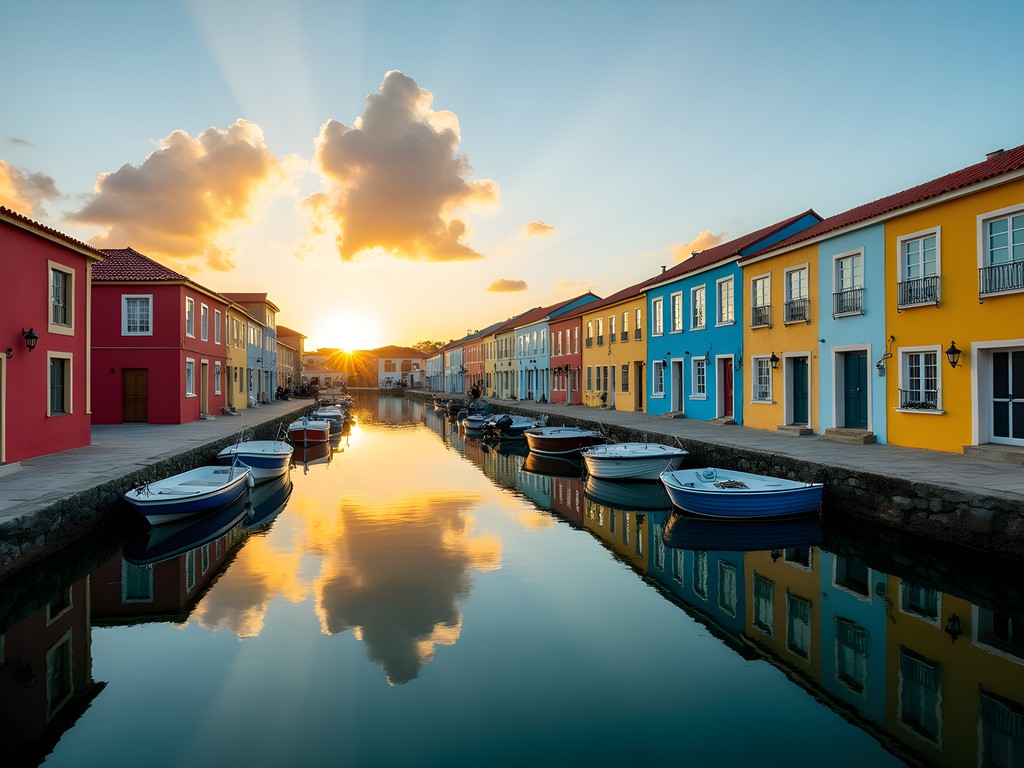
💡 Pro Tips
- Arrive before sunrise to catch the golden light on the eastern-facing buildings
- Use a polarizing filter selectively - it can enhance building colors but will remove water reflections if fully engaged
- Include local boats and fishermen for scale and cultural context
Market Square: Capturing Grenada's Soul in Color and Motion
No photographic exploration of St. George's would be complete without immersing yourself in the sensory explosion of Market Square, especially on Saturday mornings when it reaches peak vibrancy. This is where Grenada's nickname as the 'Spice Isle' comes alive through towering pyramids of nutmeg, cinnamon, and turmeric that create a photographer's dream of color and texture.
I arrived at the market around 8:30 AM, when the light was still directional but vendors had fully set up their stalls. The challenge here isn't finding subjects—it's deciding which visual feast to capture first. The market requires a different approach than the architectural photography of The Carenage. Here, I switched to my prime lens, which allowed me to work in lower light between the covered stalls while maintaining image quality.
The key to authentic market photography lies in connection. I spent my first thirty minutes simply walking around, purchasing small items, and chatting with vendors in my limited English peppered with the few Grenadian phrases I'd learned. Respeito (respect) goes a long way—always ask permission before photographing someone directly. When I showed genuine interest in their products and craft, most vendors were not only willing but enthusiastic about being photographed.
The spice stalls offer the most compelling color compositions, with their carefully arranged displays of cinnamon sticks, nutmeg, and saffron creating natural color wheels that would make any art director jealous. For these shots, I got low and shot slightly upward to capture both the products and the proud faces of the vendors against the market's corrugated metal roofing, which diffuses the harsh midday light into a flattering soft glow.
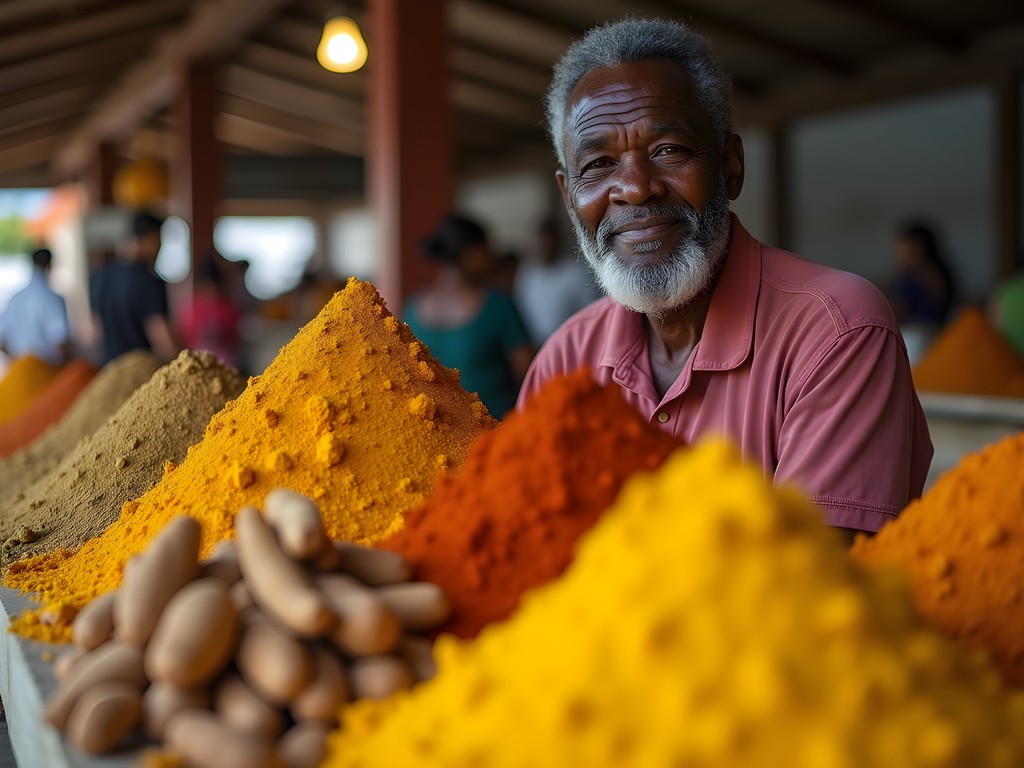
💡 Pro Tips
- Purchase small items first to build rapport with vendors before asking to photograph
- Use a fast prime lens for low-light flexibility and beautiful bokeh
- Look for complementary colors in spice displays - the oranges and yellows against blue tarpaulins create stunning contrasts
Fort George: Historical Perspectives and Panoramic Views
Perched atop a promontory overlooking St. George's, Fort George offers what is unquestionably the definitive panoramic view of the town and its perfect natural harbor. Built by the French in the early 18th century and later expanded by the British, this historical fortification provides both compelling foreground elements and breathtaking backgrounds for landscape photographers.
I timed my visit to Fort George for late afternoon, arriving around 4 PM to scout compositions before the golden hour began. The fort's stone walls take on a warm amber glow as the sun descends, creating a perfect contrast to the deep blues of the Caribbean Sea beyond. The entrance fee is a modest 5 EC$ (about 2 USD), making it one of the best photography investments you'll make in Grenada.
From a technical perspective, this location demands wide-angle photography to capture the expansive harbor views. My wide-angle zoom became my primary lens here, allowing me to frame dramatic compositions incorporating the fort's cannons and stone archways as foreground elements with the colorful town and harbor as background.
The fort offers multiple levels and vantage points, each providing a different perspective on St. George's. I found the northwestern bastion particularly compelling, where you can compose shots framing the entire horseshoe harbor through an old gun embrasure. As sunset approaches, the town's buildings begin to glow as if illuminated from within, their colors intensifying against the deepening blue sky.
For photographers interested in historical architecture, don't miss the interior courtyard with its weathered wooden structures and stone stairways. The play of light and shadow here creates moody compositions that tell the story of Grenada's complex colonial past. I spent nearly an hour photographing just the textural details of cannonballs against stone walls, finding beauty in the contrast between the instruments of war and the peaceful harbor they once protected.
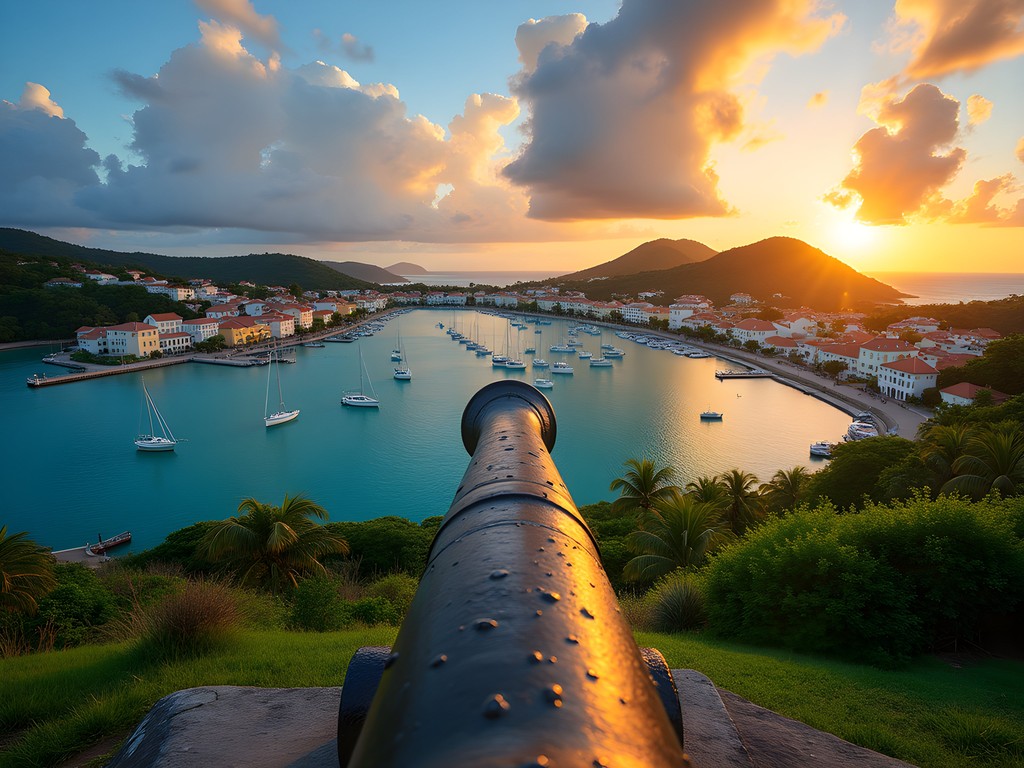
💡 Pro Tips
- Bring both wide-angle and medium telephoto lenses to capture both panoramas and compressed views of the harbor
- Use the fort's architectural elements as natural frames for your harbor compositions
- Stay until blue hour when the town lights come on for a magical contrast against the twilight sky
Architecture: Capturing the Colonial Rainbow
St. George's presents a unique architectural narrative—a visual dialogue between British colonial structure and Caribbean chromatic exuberance. The town's buildings follow traditional Georgian and Victorian forms but are painted in a palette that would make Frida Kahlo smile in approval. This juxtaposition creates a photographer's playground where formal composition meets explosive color theory.
I dedicated an entire day to architectural photography, focusing on the streets rising up from The Carenage. Young Street and Church Street offer particularly rich hunting grounds for architectural photographers. The key is to visit these areas during mid-morning (around 9-11 AM) when the sun is high enough to illuminate the facades but not so high as to create harsh shadows.
The technical challenges here are significant—narrow streets create extreme contrast between sunlit buildings and shadowed areas. I found myself constantly switching between my standard zoom for wider street scenes and my telephoto lens for isolating architectural details and compressing colorful facades into abstract compositions.
What fascinated me most was how the Caribbean light interacts with these colorful surfaces, creating secondary colors as light bounces between buildings. A yellow wall opposite a blue building creates subtle green highlights that aren't immediately obvious to the naked eye but appear magically in photographs. This is where the quality of your camera's color science becomes apparent—I found myself shooting in RAW but with careful white balance settings to capture these subtle color interactions.
Don't miss St. George's Anglican Church on Church Street, where the warm terracotta of the brick contrasts beautifully with the surrounding colorful buildings. The late colonial architecture here tells the story of Grenada's past through form, while the colors speak to its vibrant present. As a photographer with roots in both Indian and Brazilian visual traditions, I found myself drawing connections between the chromatic boldness here and the colorful buildings of Salvador da Bahia in my native Brazil—both expressions of joy and cultural identity through color.
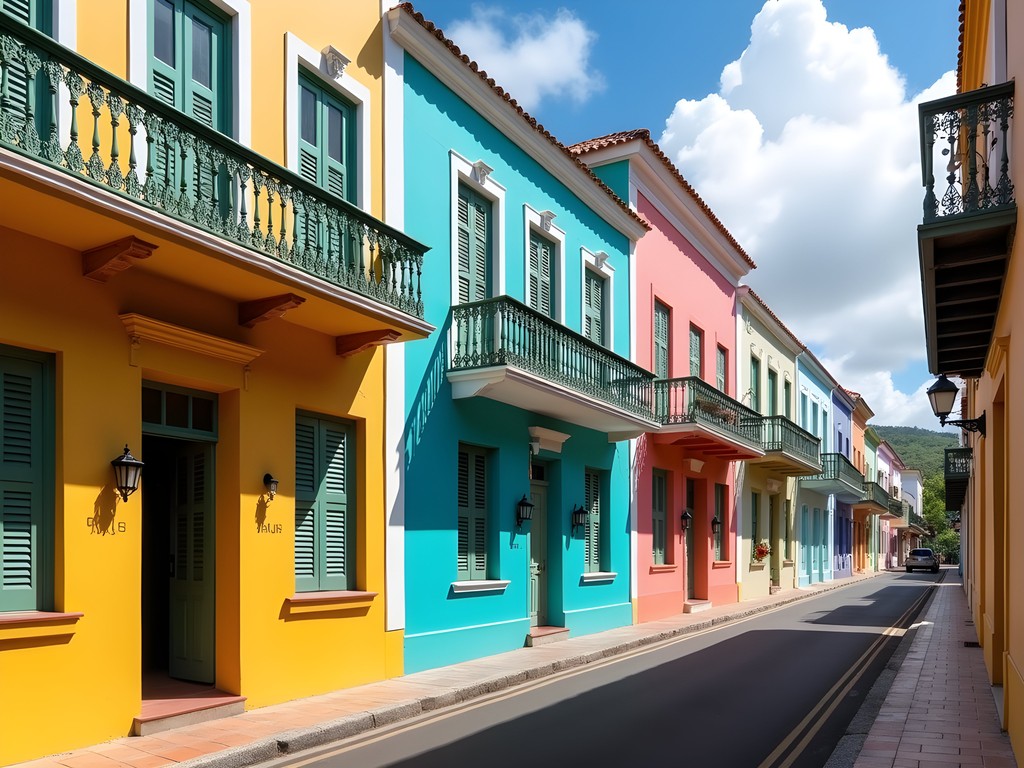
💡 Pro Tips
- Look for complementary colors between adjacent buildings - they create the most striking compositions
- Shoot with the sun at 45 degrees to building facades to capture both color and architectural detail
- Include small human elements for scale and to bring architectural compositions to life
Blue Hour Magic: St. George's After Dark
While St. George's is undeniably a destination that shines in daylight, some of my most compelling images came during the brief Caribbean blue hour, when the town transforms into something approaching a film set. As an engineer who appreciates the technical aspects of photography, this magical time between sunset and full darkness presents both challenges and opportunities that technical-minded photographers will relish.
The key location for blue hour photography is undoubtedly the elevated viewpoints east of town, particularly the road leading up to Fort Frederick. I scouted this location during daylight hours, identifying the perfect spot where I could set up my travel tripod with a clear view of the harbor. Arriving about 20 minutes before sunset gave me time to compose carefully and prepare for the rapid light transition.
The technical demands of blue hour photography are significant. You'll need a stable tripod, remote shutter release, and patience. I worked primarily with 8-15 second exposures at f/8, ISO 100, gradually lengthening the exposure as darkness increased. The magic happens when the ambient light balances perfectly with the town's artificial lighting—usually about 15-20 minutes after sunset.
What makes St. George's particularly special during blue hour is how the colorful buildings, now illuminated by warm artificial light, pop against the deep blue sky. The harbor water, still holding some light, creates a perfect reflective surface that doubles the visual impact. I found myself working quickly, taking bracketed exposures every few minutes as the light rapidly evolved.
For those willing to venture into night photography, the Carenage takes on a completely different character after dark. The harbor lights create starbursts and reflections that transform the daytime scene into something more intimate and mysterious. Here, I pushed my camera's capabilities with longer 20-30 second exposures that smoothed the harbor water into a mirror-like surface reflecting the town lights.
Lembre-se—remember that St. George's is a small town that largely goes to sleep early. While perfectly safe, some areas have minimal lighting after dark, so bring a headlamp for navigating between photo locations and respect residential areas during your night photography adventures.

💡 Pro Tips
- Scout your blue hour locations during daylight to identify composition options and tripod placement
- Bring a neutral density filter to extend exposures if you want glassy water effects in harbor shots
- Work quickly during the actual blue hour transition - the best light lasts only about 20 minutes
Final Thoughts
As I packed away my gear on my final evening in St. George's, watching the last light fade over the harbor from my guesthouse balcony, I realized this small Caribbean capital had fundamentally changed how I approach color in my photography. The town's unapologetic embrace of vibrant hues against the backdrop of colonial architecture creates a visual language that speaks to both history and joy—a perfect metaphor for Grenada itself. Whether you're a seasoned photographer or simply someone who appreciates beauty through a viewfinder, St. George's rewards those who take time to observe how light transforms its colorful canvas throughout the day. Até a próxima aventura—until the next adventure, may your memory cards return home full of Grenada's remarkable colors and the stories they tell.
✨ Key Takeaways
- The best photography opportunities come at transition times - early morning, golden hour, and blue hour
- Building rapport with locals enhances both your experience and your photography
- Look for the interplay between colonial architectural structure and Caribbean color expression
- Technical preparation (filters, tripod, lens selection) significantly impacts your ability to capture St. George's unique light
📋 Practical Information
Best Time to Visit
December to April (dry season with optimal light)
Budget Estimate
$100-150 USD per day including mid-range accommodation and meals
Recommended Duration
4-7 days for comprehensive photography coverage
Difficulty Level
Moderate (Hilly Terrain Requires Reasonable Fitness)








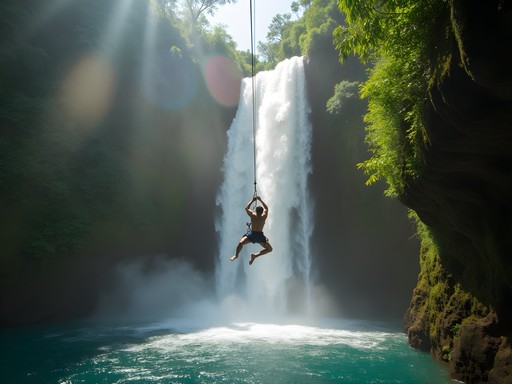
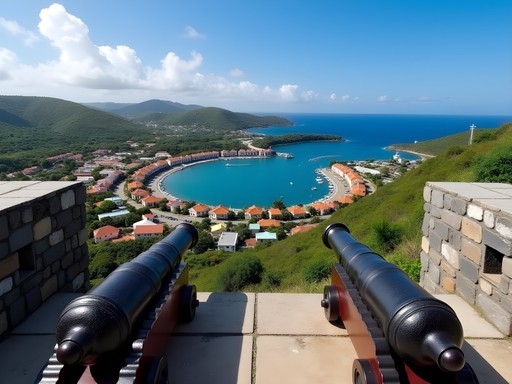
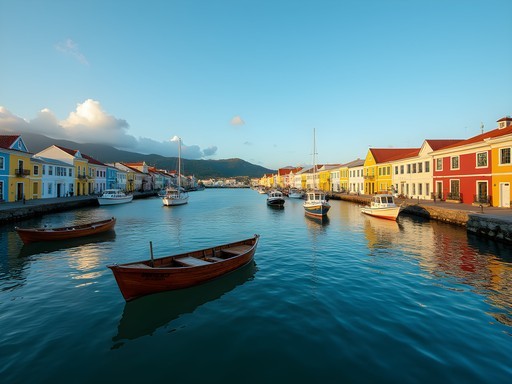





Comments
CaribbeanDreamer
Just wow! The colors in those buildings look unreal!
wanderlustbackpacker
Right?? I showed these to my partner and now we're planning a trip there!
sunshine_traveler
Those harbor shots are stunning! What time of day did you take them?
island_hopper22
Going to Grenada next month! Is it worth bringing my big DSLR or would a good phone camera be enough for the markets?
Douglas Bradley
Not Marco, but I'd say bring the DSLR if you're serious about photography. The light contrast in the markets can be challenging for phone cameras. A fast prime lens would be ideal for the market scenes.
Marco Sharma
Agree with Douglas! The colors really pop with proper equipment, but the market can get crowded so consider a smaller mirrorless setup if you have one. A 35mm prime worked perfectly for me.
Douglas Bradley
Excellent guide, Marco! I visited St. George's last year and can confirm The Carenage is magical for photography, especially with that morning light you mentioned. I found positioning myself near the fish market around 7-8am gave the perfect combination of local activity and golden light on the colorful boats. One addition I'd suggest for photographers is Fort Frederick, which offers a different perspective than Fort George - fewer tourists and some unique vantage points of the southern coastline. I used my travel tripod for some long exposures at sunset there. Did you get a chance to photograph any of the island's waterfalls? I found Chelsea Falls particularly photogenic with the right polarizing filter.
Marco Sharma
Thanks Douglas! Great tip about Fort Frederick - I only had time for Fort George but will definitely check it out next time. And yes, I did visit Chelsea Falls but saved that for my upcoming post on Grenada's natural landscapes!
wanderlustbackpacker
Those colors in your market photos are incredible! Added St. George's to my bucket list just for that!
Marco Sharma
Thanks! The market was definitely a highlight - go early morning for the best light and fewer crowds!
wanderlustbackpacker
Will do! Any specific day of the week that's best?
Marco Sharma
Saturday mornings are busiest but most vibrant. Wednesdays are good too with fewer tourists.
freepro
Just wanted to add - if you're shooting the market, ask permission first! I bought a few small items and then asked if I could take photos. Made for much more relaxed and authentic shots of the vendors. The spice stalls with their pyramids of colorful powders are absolutely worth capturing!
Marco Sharma
Great point about asking permission! I should have emphasized that more in the post. Building rapport first always leads to better photos.
Hunter Thompson
Marco mate, absolutely buzzing over this guide! I backpacked through Grenada last year and St. George's was a proper photographer's dream. That section about Fort George's panoramic views is spot on - I spent an entire sunset up there watching the light change over the harbor. For anyone heading there, bring plenty of water for the climb up! Also found that early morning (like 6-7am) at the Carenage is magical - the fishing boats coming in, hardly any tourists, and that golden light hitting the colored buildings... pure magic for photos! Can't wait to see where your camera takes you next!
mountainguide
Great post! I'm heading to Grenada in January and want to capture those vibrant buildings. What lens setup would you recommend for the narrow streets and architecture? I'm using a Sony A7III and debating between taking my 24-70mm or going wider with the 16-35mm.
Marco Sharma
For St. George's narrow streets, I found my 16-35mm invaluable! The wider angle really helps capture the full facades of those colorful buildings when you can't back up far enough. The 24-70mm is perfect for the harbor views though. If you can only bring one, I'd lean toward the wider option.
freepro
I second the wide angle recommendation. I used my ultra-wide lens in similar Caribbean towns and it was perfect for those tight colorful streets.
smartchamp
Just got back from Grenada last month and your photos capture the essence perfectly! The Carenage really does look magical in morning light. I found the locals incredibly welcoming when I took photos, especially after buying some spices first. Did you get a chance to photograph any of the nutmeg processing? That was a highlight for me - all those rich browns and yellows against the workers' colorful clothing.
Marco Sharma
I did visit a nutmeg processing station! You're right about those colors - absolutely stunning contrasts. I might do a follow-up post focused just on Grenada's spice industry.
adventurephotographer4888
Those market photos are incredible! The colors really pop. What time of day did you shoot there?
Marco Sharma
Thanks! I shot most of the market scenes between 8-10am when the morning light filters through but before it gets too harsh. The vendors are also setting up then so there's lots of activity to capture.
adventurephotographer4888
Perfect timing! I'll keep that in mind for my trip next year.
Venture X
Premium card with 2X miles, $300 travel credit, Priority Pass